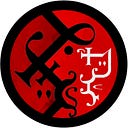Cocytus — Divination Magic and the Soothsayers
Time is not a thing that can be stretched or sliced. It can’t even be looked at directly, just its consequences. Time is like air: you feel a breeze and get a hint of where the leaves will go.
The Divination school of magic concerns itself with perceptions, especially seeing things far in space or time.
Divination spells can’t make you see what will definitely happen, but only what is most likely to happen.
Divination is one of the disciplines more studied and less understood.
Recent magical studies have confirmed the “pulse theory” of divination mechanics: the caster excites the strands of Indigo Mana, like shaking a long rope making waves, and gets feedback. The Indigo Mana waves’ behavior gives hints of the “path of least resistance” of the mana field, where it “wants” to go, and where the “rest points” are. Since the Mana Field and material reality interact, one can deduct the implied “most probable reality” from the field configurations.
Diviners are trained to instinctively perceive the abstract designs of the mana field as sensorial information: sounds, images, smells, etc.
There are many obstacles to good foretelling: it’s easier to guess the future of a single object or living things than complex events, the further in space and time, the lesser the prediction is reliable, and the images received can be lacking in detail or obscure in meaning.
Wizards are good at predicting vast and complex phenomena, but it takes them a long time and many spells to declare their response. Wizards are fixated on accuracy and will foretell only after the events are in motion, otherwise, they say, it is just an educated guess. So, if you ask a wizard how the fish season will turn out, they will give you the answer only after the ships set sail, and the answer will be papers and papers of quantities and probabilities.
Clerics are good at predicting far in the future, like a whole lifetime or even an entire century, but are usually vague, with ambiguous semantic and cryptic symbols, to secure a sort of “plausible deniability” in the events they were wrong. Divine magic is not the strong suit of Cocytus and, despite the general interest in divination, they are not the first in prophets and prophecies: the honor belongs to Cania, the epicenter of divine magic.
One of the reasons for such underdevelopment in clerical magic is that druidism overlaps with it, becoming competitors, especially regarding foretelling.
In other parts of the empire, druids’ groves become priestly or monastic orders, so their holistic magic and philosophy could be tamed, and any heretic idea culled (nobody wants another Spirits’ Way disaster). On the other hand, Cocytus is far from the reach of Goetia and Astaroth, the seats of political and religious power, and they couldn’t (or just couldn’t be bothered) to separate druids from their old ways. Besides a vow of fidelity to the Church, Coytian druids are completely autonomous, choosing their duties and objectives on their own.
Druids are excellent in divination but with a limited scope: they can predict wheater patterns and animal migrations with pinpoint precision, on long distances, and months in advance, but are limited in any non-nature-related field.
Many druids live selling wheater forecasts and many captains will employ one of them as part of the crew. Or at least they will try: druids will choose to work on a ship not for money but for other reasons, be they personal, religious, moral, or known only to them.
As Cocytian druids never integrate into the church, so the Soothsayers never became part of the academic arcanist tradition.
Soothsayers are easily spotted in harbor towns: their face is covered by a veil, and their bodies by many tattoos. They are almost always women, and they adopt orphan girls to pass on their craft and secrets, in a distinctly female tradition.
The Soothsayers sell their prediction mainly to sailors, anxious to know what the sea has in store for them. They alternate very vague images with precise details, winding compelling stories and evoking vivid images. Thanks to these tales, they often convince sailors to cheat fate: if a soothsayer saw the client’s hand bit by a sea monster, they will suggest “change it” with a tattoo. The inked hand is then different from the one in the vision, and so the events in it are less likely to happen. Of course, the Soothsayers will make the tattoo themselves, for a little extra.
Sailors’ wives are also good customers, asking the soothsayer the destiny of rope bracelets, scarfs, or handkerchiefs they are gonna give their husbands: if the fate of the object is “good” (it returns, it doesn’t end in the sea, it always on the beloved person) then it becomes a lucky charm. If the soothsayer sees a “bad” future for the object, it’s then jinxed, and destroying it will bring good luck (the soothsayer will dispose of the “cursed item”, for a little extra).
Many Soothsayers are talented, or at least competent, but others are little more than scammers, telling their clients what they want to hear, or what’s more profitable, spinning enticing responses from little glimpses.
The locals can usually discern the real deal from the con women, but travelers can be easily fooled by their silver tongues. Credentials are then crucial: talented soothsayers are sought after by captains and have served on many ships.
The doomed romance between a Soothsayer and a captain of a monster-hunting ship has become a fashionable topic for Cocytian operas, with a different mix of melodrama, action, romance, and erotism based on the authors’ taste. Some prostitutes are even starting to put on a veil and draw fake tattoos on them to capitalize on this new fascination for the harbors’ diviners.
